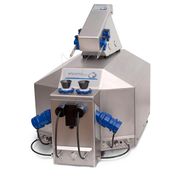Difference between revisions of "High-resolution respirometry"
| Line 1: | Line 1: | ||
{{MitoPedia | {{MitoPedia | ||
|abbr=HRR | |abbr=HRR | ||
|description='''High-resolution respirometry''' ([http://www.oroboros.at/index.php?high-resolution-respirometry HRR]) is based on the [[Oxygraph-2k|OROBOROS Oxygraph-2k]], combining chamber design, application of oxygen-tight materials, electrochemical sensors and electronics, Peltier-temperature control and software features ([[DatLab]]) to obtain a unique level of quantitative resolution of [[oxygen concentration]] and [[oxygen flux]], with a closed-chamber or open-chamber mode of operation ([[Titration-Injection microPump|TIP2k]]). Standardized two-point calibration of the polarographic oxygen sensor ([[POS calibration|static sensor calibration]]), calibration of the sensor response time ([[POS calibration|dynamic sensor calibration]]), and evaluation of [[instrumental background oxygen flux]] (systemic flux compensation) provide the experimental basis for high accuracy of quantitative results and quality control in HRR. | |description=[[Image:O2k-Fluorescence LED2-Module.JPG|180px|left|link=http://www.bioblast.at/index.php/O2k-Fluorescence_LED2-Module]] | ||
'''High-resolution respirometry''' ([http://www.oroboros.at/index.php?high-resolution-respirometry HRR]) is based on the [[Oxygraph-2k|OROBOROS Oxygraph-2k]], combining chamber design, application of oxygen-tight materials, electrochemical sensors and electronics, Peltier-temperature control and software features ([[DatLab]]) to obtain a unique level of quantitative resolution of [[oxygen concentration]] and [[oxygen flux]], with a closed-chamber or open-chamber mode of operation ([[Titration-Injection microPump|TIP2k]]). Standardized two-point calibration of the polarographic oxygen sensor ([[POS calibration|static sensor calibration]]), calibration of the sensor response time ([[POS calibration|dynamic sensor calibration]]), and evaluation of [[instrumental background oxygen flux]] (systemic flux compensation) provide the experimental basis for high accuracy of quantitative results and quality control in HRR. | |||
|info=[[MiPNet06.01]]; [[Gnaiger_2008_POS]]; [[Gnaiger_2001_Respir Physiol]] | |info=[[MiPNet06.01]]; [[Gnaiger_2008_POS]]; [[Gnaiger_2001_Respir Physiol]] | ||
|type=Respiration | |type=Respiration | ||
Revision as of 13:40, 9 May 2014
Description
High-resolution respirometry (HRR) is based on the OROBOROS Oxygraph-2k, combining chamber design, application of oxygen-tight materials, electrochemical sensors and electronics, Peltier-temperature control and software features (DatLab) to obtain a unique level of quantitative resolution of oxygen concentration and oxygen flux, with a closed-chamber or open-chamber mode of operation (TIP2k). Standardized two-point calibration of the polarographic oxygen sensor (static sensor calibration), calibration of the sensor response time (dynamic sensor calibration), and evaluation of instrumental background oxygen flux (systemic flux compensation) provide the experimental basis for high accuracy of quantitative results and quality control in HRR.
Abbreviation: HRR
Reference: MiPNet06.01; Gnaiger_2008_POS; Gnaiger_2001_Respir Physiol
MitoPedia methods:
Respirometry,
Fluorometry,
Spectrophotometry
Links
Physiological temperature
We recommend determining mitochondrial respiratory activity at the physiologic temperature of a biologic system, no matter whether you work with biopsies, cultivated cells or isolated mitochondria. When measuring in an appropriate medium (protecting and stabilizing mitochondrial function) stability is preserved even in isolated mitochondria.
Oxygraphy: Linear versus non-linear slope
Oxygen dependence of respiration
In isolated mitochondria and many types of small cells (such as endothelial cells, fibroblasts etc), zero-order kinetics with respect to oxygen pressure (i.e. independence of flux with declining oxygen concentration) applies over a wide range down to very low oxygen levels, where then a hyperbolic oxygen dependence is observed. With a p50 (c50, apparent Km) in the order of <1 µM and a hyperbolic oxygen dependence of flux, 99% saturation of flux and hence zero-order kinetics is observed at an oxygen concentration >19 µM (i.e. >2 kPa, >2% oxygen saturation or >10% air saturation). For reviews see Gnaiger et al 1995, Scandurra and Gnaiger 2010.
Compared to the difficulties with classical chart recorder tracings, our 'modern' approaches over the past 20 years allowed us to drop the linearity assumption and statistically test for it, frequently rejecting this assumption to describe a non-linear oxygen dependence beyond the low-oxygen range governed by cytochrome c oxidase. For review see Gnaiger 2003.
In permeabilized muscle fibres (30 to 37 °C), oxygen kinetics is shifted 100-fold due to artifially high oxygen gradients, forcing us to apply elevated oxygen levels for obtaining near-zero-order kinetics. For details, see Pesta and Gnaiger 2012, Gnaiger 2003, and Discussion.
ADP dependence of respiration
The assumption of linearity (linear regression of oxygen concentration over time) is frequently not valid for various reasons other than oxygen kinetics. In classical ‘State 3’, ADP levels are ‘high’ (Chance and Williams 1955), but not necessarily saturating (Glossary: Respiratory states). Then, an ADP-dependent decline of respiration is observed immediately after titration of a sub-saturating concentration of ADP, which is obscured by any linear regression. This has caused in the past a tremendous underestimation of the apparent Km for ADP, perpetuated even today with the uncritical application of non-adequate software implementing the simple linearity approach only. For a critical approach to ADP kinetics, see Gnaiger et al 2000 and Gnaiger 2001.
Titration of chemicals
Do overshoots or short interruptions of the flux have a meaning after injection of chemicals?
Neither the overshoot nor the short signal disturbance is representing mitochondrial respiration. The disturbance of the signal is due to the injection of the chemical. With the addition of chemicals solved in ethanol a little bit of oxygen is always introduced, since ethanol has higher oxygen solubility than water.
Various

